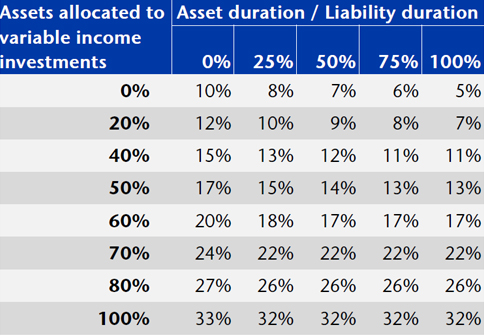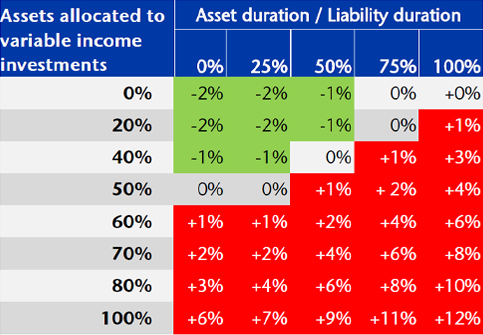Information Bulletin: Funding of Quebec Pension Plans – New scale proposed for establishing the target level of the stabilization provision
The main purpose of the regulation published on November 20 in the Gazette officielle du Québec is to revise the scale for establishing the target level of the stabilization provision of private-sector defined benefit pension plans. In this regard, the final version of the regulation offers no surprises: the scale that will apply to actuarial valuations dated December 31, 2019, or later is identical to the one proposed in the draft regulation published on July 3, 2019. In addition, under the regulation, plans that do not produce a valuation as at December 31, 2019 do not have to establish a new target level of stabilization provision dependent on the new scale at this date. The new scale will only apply to the next actuarial valuation which will require the establishment of the target level of the stabilization provision.
The final version of the regulation includes few changes when compared with the draft published on July 3. Consequently, this issue includes much of the same information contained in our July bulletin.
Scale for determining the stabilization provision
Note that since 2016, the solvency deficits of private-sector pension plans no longer need to be funded. However, the going concern approach must include a stabilization provision that is based on a scale dependent on the investment policy.
The new scale applies to actuarial valuations dated December 31, 2019 or later
As a general rule, the proposed scale determines target levels of the stabilization provision that are greater than those determined by the current scale. Here are some observations:
- For a typical plan where the assets allocated to variable-income investments are between 50% and 60% and the ratio of the asset duration to the liability duration is between 25% and 50%, the target level of the stabilization provision will be increased by 1% to 2%.
- For plans with a stabilization deficit (plans that either are in deficit or have a surplus below the target level less 5% on a going concern basis), the increase may constitute a significant financial burden, in particular for mature plans for which an increase of 1% to 2% of the provision to be funded represents a significant proportion of the payroll.
- Plans for which the proposed scale includes the greatest increases are those where the asset duration/liability duration ratio is greater than 50% and the variable-income proportion is equal to or greater than 60%. For instance, the stabilization provision target level for a plan with an asset duration/liability duration ratio of 75% and with 60% variable-income investments would be increased by 4% (from 13% to 17%). As such, the new scale will:
- Require a greater provision for plans with relatively aggressive investment policies;
- Be less favourable than the current scale to plans that favour tighter management of the interest rate risk with a long duration of their bond portfolio.
New scale

Differences between proposed scale and current one

Unquoted private debt as fixed income security
A positive change under the regulation is recognition, when certain conditions are met, of unquoted private debt as fixed-income security, up to 10% of the plan’s assets. This type of investment is already garnering interest among pension committees, and this change should increase their interest. In fact, by being a “fixed-income security”, the asset proportion allocated to variable-income securities is reduced, thus allowing the target level of the stabilization provision to be decreased and to take full advantage of the features of such an investment as opposed to the current scale.
Calculation of asset duration
As a result of the changes introduced by the regulation, the investments to be taken into account when determining the percentage of the assets allocated to fixed income investments are now different from those included in the calculation of the asset duration. For this latter calculation, the following additional investments must be considered:
- Money market and bond market securities with a rating lower than the minimum required to be considered a fixed income investment are now taken into account (e.g. high-yield bonds);
- All first or second mortgages;
- Infrastructure or real estate investments are now included at 100% rather than 50%;
- Investments in unquoted private debt are now included, whether or not they meet the minimum requirements for a fixed income investment. These investments are currently completely excluded from duration calculations.
For those plans in which a significant portion of the assets is allocated to such investments, this change could reduce the target level of the stabilization provision and could, where necessary, reduce the contributions required.
Other changes
A few more technical changes are also included in the regulation (the first two apply to all sectors, while the last one applies to the private sector):
- Increase in the cap for the fees payable when registering a pension plan, filing the annual information return, or transmitting the termination report from $100,000 to $150,000. The new ceiling will apply starting on December 31, 2019 and will be indexed starting on January 1, 2020. It involves a limited number of plans;
- Elimination of additional fees for the notice of solvency required under section 119.1 of the Supplemental Pension Plans Act or for a report related to an actuarial valuation in cases where such a report has been filed on the date when the notice of solvency or actual valuation was required or on an earlier date.
- Changes to the information required in the report related to a partial actuarial valuation in the event such a valuation is done to take into account plan amendments with an impact on the funding of the plan or following an agreement with an insurer to settle benefits in accordance with the plan’s annuity purchase policy.
Conclusion
The changes related to the stabilization provision are to come into force on December 31, 2019. In the event that an actuarial valuation is produced at that date, the late publication of the final version of the regulation gives the interested parties little time to adequately manage the transition from the current scale to the new one. Promoters who want to minimize the negative impact of the new scale by reviewing their asset allocation (by including more private debt, for example), must act quickly to change the plan’s investment policy. Under section 125 of the Supplemental Pension Plans Act, it is the investment policy in force on the date of the actuarial valuation that must be taken into consideration to establish the target level of the stabilization provision.
Contact Information
Should you wish additional information on this topic, please contact your local Aon consultant, or send an email to [email protected].
Aon publishes Information Bulletin for the purposes of providing general information. The information in Information Bulletin does not constitute financial, legal, or any specific advice and should not be used as a basis for formulating business decisions. For information tailored to your organization’s specific needs, please contact your consultant at Aon. This issue of Information Bulletin contains information that is proprietary to Aon and may not be distributed, reproduced, copied or amended without Aon’s prior written consent.